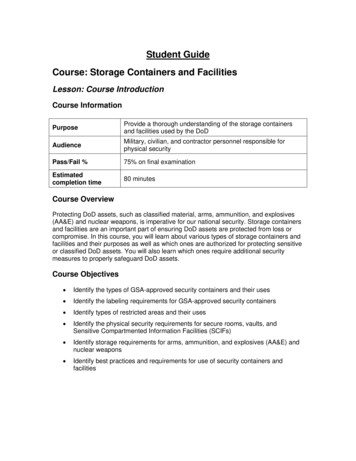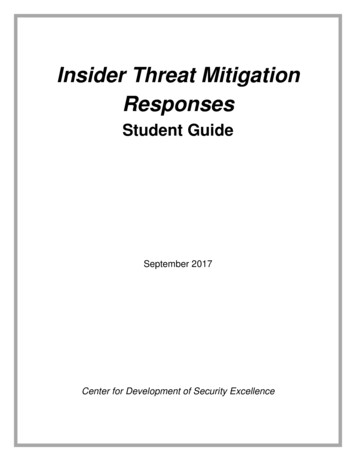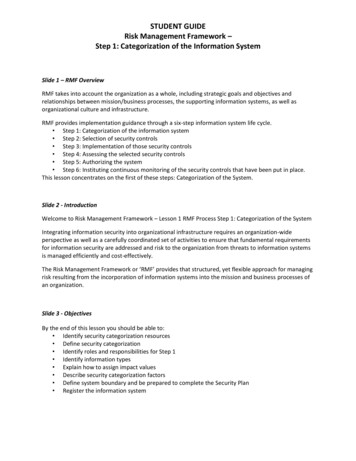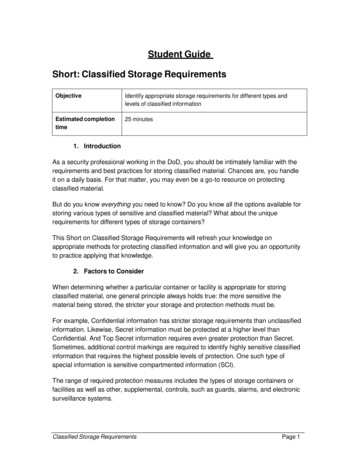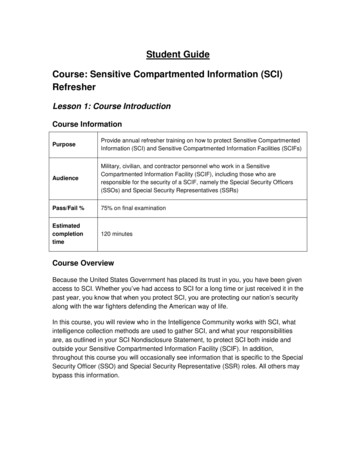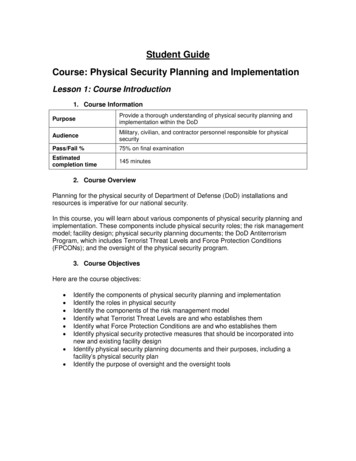
Transcription
Student GuideCourse: Physical Security Planning and ImplementationLesson 1: Course Introduction1. Course InformationPurposeProvide a thorough understanding of physical security planning andimplementation within the DoDAudienceMilitary, civilian, and contractor personnel responsible for physicalsecurityPass/Fail %75% on final examinationEstimatedcompletion time145 minutes2. Course OverviewPlanning for the physical security of Department of Defense (DoD) installations andresources is imperative for our national security.In this course, you will learn about various components of physical security planning andimplementation. These components include physical security roles; the risk managementmodel; facility design; physical security planning documents; the DoD AntiterrorismProgram, which includes Terrorist Threat Levels and Force Protection Conditions(FPCONs); and the oversight of the physical security program.3. Course ObjectivesHere are the course objectives: Identify the components of physical security planning and implementationIdentify the roles in physical securityIdentify the components of the risk management modelIdentify what Terrorist Threat Levels are and who establishes themIdentify what Force Protection Conditions are and who establishes themIdentify physical security protective measures that should be incorporated intonew and existing facility designIdentify physical security planning documents and their purposes, including afacility’s physical security planIdentify the purpose of oversight and the oversight tools
Physical Security Planning and ImplementationCourse IntroductionStudent Guide4. Course StructureThis course is organized into the lessons listed here: Course IntroductionWhat is Physical Security Planning and Implementation?Facility DesignPhysical Security Planning DocumentsDoD Antiterrorism ProgramOversightCourse ConclusionPage 2
Student GuideCourse: Physical Security Planning and ImplementationLesson 2: What is Physical Security Planning andImplementation?Lesson Introduction1. ObjectivesThis lesson will familiarize you with a variety of concepts related to physical securityplanning and implementation in the Department of Defense (DoD), including the riskmanagement process and the various roles involved in the planning and implementationof physical security.Lesson objectives: Identify the components of physical security planning and implementationIdentify the components of the risk management modelIdentify the roles in physical security2. OverviewPhysical security planning is deciding which security measures will be used to preventunauthorized access to DoD assets and to safeguard those assets against threats suchas espionage, sabotage, terrorism, damage, and criminal activity. In physical securityplanning, the risk management process is used to provide a systematic approach toacquiring and analyzing the information necessary for protecting assets and allocatingsecurity resources against the threats.Physical security implementation is the execution of physical security plans, includingthe oversight and inspection process, which ensures those plans are properlyimplemented.3. PolicyThe DoD has implemented several DoD-wide policy documents that guide DoD physicalsecurity planning and implementation, such as: DoD 5200.08-R, Physical Security ProgramDoD Instruction (DoDI) 5200.08, Security of DoD Installations and Resourcesand the DoD Physical Security Review Board (PSRB)DoD Directive (DoDD) 3020.26, DoD Defense Continuity ProgramDoDI 2000.12, DoD Antiterrorism ProgramDoDI 2000.16, DoD Antiterrorism StandardsDoD Antiterrorism Officer Guide
Physical Security Planning and ImplementationWhat is Physical Security Planning and Implementation? Student GuideDoDM 5200.01 DoD Information Security ProgramThe Army, Navy, Marine Corps, and Air Force issue specific implementation guidancefor their individual service branches. You should always consult your component’s policyfor specific guidance.Physical Security Planning1. Risk Management ProcessIn order to plan and implement effective physical security measures, you must use therisk management process to determine where and how to allocate your securityresources. The steps in the risk management process are: assess assets; assessthreats; assess vulnerabilities; assess risks; determine countermeasure options; andmake risk management decisions.For in-depth training on the risk management process, refer to the Risk Management forDoD Security Programs eLearning course offered by DSS Center for Development ofSecurity Excellence.a. Assess AssetsProperly designed and executed physical security programs should deter orprevent, to the greatest degree possible, the loss of, theft of, or damage to anasset. DoD assets include people, information, equipment, facilities, activities,and operations. Combined, these assets are referred to as PIE-FAO. Whenassessing an asset, you must determine the nature and value of that asset andthe degree of impact if the asset is damaged or lost.b. Assess ThreatsNext you must identify and assess the threats to those assets. A threat can be anindication, circumstance, or event with the potential to cause loss of, or damageto, an asset or capability. Examples of threats include threats from the ForeignIntelligence Entities, criminal activities, insider threats, terrorist organizations,cyber threats, and business competitors.c. Assess VulnerabilitiesNext you must identify the vulnerabilities, or situations or circumstances, which ifleft unchanged, may result in the degradation, loss of life, or damage to missionessential resources, and determine their extent. Vulnerabilities are weaknesses,characteristics, or circumstances that can be exploited by an adversary to gainaccess to or information from an asset. Vulnerabilities can be the result of avariety of factors, such as the way a building was constructed, location of people,equipment, operational practices, and even personal behavior.Page 2
Physical Security Planning and ImplementationWhat is Physical Security Planning and Implementation?Student Guided. Assess RisksOnce you have identified your assets, threats, and vulnerabilities, you must thenassess your risks. Think about the impact if your assets are being compromised,such as loss of strategic or military advantage or even loss of life.e. Determine Countermeasure OptionsOnce you’ve calculated the risks, you must determine which countermeasuresyou might employ to protect our DoD assets by reducing our vulnerabilities andmitigating our threats. Countermeasures include what security measures youemploy up front in facility design, in the day-to-day protection of DoD assets, andin times when threat levels increase.f.Make Risk Management DecisionsOnce you’ve determined your countermeasure options, you must make riskmanagement decisions based on the cost versus the benefit of protecting DoDassets.2. ActivitiesSeveral activities comprise the physical security planning phase. Physical securityplanning must begin with the design of any facility, installation, or mission. Includingphysical security measures in the design phase is critical to the protection of missioncapabilities and is essential for an effective physical security program.Physical security planning includes the creation of written plans, such as the PhysicalSecurity Plan, Standard Operating Procedures, and Post Orders. Experience has proventhat by establishing written plans, all people involved understand their roles,responsibilities, and procedures both in the day-to-day physical security program as wellas in the event of an emergency.Physical security planning also includes antiterrorism, or AT, planning, which is planningfor the defensive measures to be used to reduce the vulnerability of individuals andproperty to terrorist attacks.Physical Security Implementation1. ActivitiesPhysical security implementation occurs in a variety of ways. When you incorporatephysical security measures in the construction or renovation of facilities according to thefacility design plans, you are implementing physical security.The various physical security planning documents are used to implement physicalsecurity measures both on a day-to-day basis and in emergency situations.Page 3
Physical Security Planning and ImplementationWhat is Physical Security Planning and Implementation?Student GuideWhen implementing antiterrorism measures, the DoD uses Terrorist Threat Levels andForce Protection Conditions to communicate levels of threat in specific areas and whatsecurity measures are to be used in response to those threats.To ensure the appropriate implementation of physical security measures, you can use avariety of oversight tools. These tools include day-to-day observations, surveys, staffassist visits, inspections, and analysis of reports.You will learn more about each of these topics later in this course.Physical Security Roles1. Groups Involved in Physical SecurityPhysical security is not about one entity taking care of everything, but rather anintegrated and coherent effort for the protection of national security and other DoDassets. There are several groups and individuals involved in physical security planningand implementation. As a physical security specialist, you will assume some of theseroles, serve on many of these working groups, and interact with others. The groupsinvolved in physical security planning and implementation include the AntiterrorismWorking Group (ATWG), Information Systems Security Managers (ISSMs), LegalOfficers, the Threat Working Group (TWG), and the Defense Critical InfrastructureProgram (DCIP) working group.a. ATWGAs outlined in DoD Instruction (DoDI) 2000.16, DoD Antiterrorism Standards, theAntiterrorism Working Group (ATWG) meets at least semi-annually and overseesthe implementation of the Antiterrorism (AT) program that protects DoD assetsagainst terrorism. They accomplish this by developing and refining AT plans andaddressing emergent or emergency AT Program issues. The ATWG comprisesthe Antiterrorism Officer (ATO), the Installation Commander or designatedrepresentative, representatives of the principal staff, including a chemical,biological, radiological, nuclear, and high yield explosive representative, tenantunit representatives, and others as directed by Installation Commanders.b. ISSMsThe Information Systems Security Managers (ISSMs) are responsible for thesecurity of information systems. They coordinate physical security measures anddevelop contingency plans for the protection of the information systems.c. Legal OfficersLegal Officers work closely with the Antiterrorism Officer and others to ensurethat security considerations are properly and legally incorporated into thephysical security plan.Page 4
Physical Security Planning and ImplementationWhat is Physical Security Planning and Implementation?Student Guided. TWGAs outlined in DoD Instruction (DoDI) 2000.16, DoD Antiterrorism Standards, theThreat Working Group (TWG) meets at least quarterly and is responsible fordeveloping and refining terrorism threat assessments based on the threatsagainst DoD assets. The TWG also coordinates and disseminates threatwarnings, reports, and summaries. This group comprises an AntiterrorismOfficer, the Installation Commander or designated representative, members ofthe staff, tenant unit representatives, law enforcement representatives, and theIntelligence Community (IC).e. DCIPAs outlined in Department of Defense Directive (DoDD) 3020.40, DoD Policy andResponsibilities for Critical Infrastructure, the Defense Critical InfrastructureProgram (DCIP) working group is responsible for developing and providinginstallation Critical Infrastructure Protection (CIP) policy, program execution, andoversight recommendations, which include identifying and prioritizing missionessential critical assets and infrastructures and assessing their vulnerability andrisk to human error, natural disasters, or intentional physical or cyber attack. Thisgroup also develops strategies for remediating or mitigating vulnerabilities andrisks to critical assets and infrastructures.The information in the box below will not be on the test, but it may provide you with useful background andinsights.The Antiterrorism (AT) program is one of several security-related programs that fallunder the overarching Combating Terrorism and Force Protection programs. The ATprogram is a collective, proactive effort focused on the prevention and detection ofterrorist attacks against DoD personnel, their families, facilities, installations, andinfrastructure critical to mission accomplishment as well as the preparation to defendagainst and planning for the response to the consequences of terrorist incidents.Although not elements of AT, plans for terrorism consequence managementpreparedness and response measures as well as plans for continuing essential militaryoperations are important adjuncts to an effective AT program. The minimum elements ofan AT program are AT risk management, planning, training and exercises, resourceapplication, and a program review.2. Individuals Involved in Physical SecurityThe agencies and organizations that protect our national security and DoD assets arecomprised of individuals who play an important part in the mission of physical security.These individuals include the Installation Commander or Facility Director; theAntiterrorism Officer (ATO); Counterintelligence (CI) support personnel; local, state, andfederal law enforcement officials; the Operations Security (OPSEC) Officer;the Physical Security Officer; the Defense Critical Infrastructure Program (DCIP) Officer;and the Civil Engineer.Page 5
Physical Security Planning and ImplementationWhat is Physical Security Planning and Implementation?Student Guidea. Installation Commander/Facility DirectorInstallation Commanders or Facility Directors are responsible for several aspectsof physical security. These responsibilities include the safety and protection ofthe people and property under their command; planning, forming, coordinating,and integrating all physical security matters into their installation; and identifyingmission essential capabilities.Department of Defense Instruction (DoDI) 5200.08, Security of DoD Installationsand Resources and the DoD Physical Security Review Board (PSRB), authorizescommanders to issue regulations for the protection and security of property orplaces under their command and to take reasonably necessary and lawfulmeasures to maintain law and order and to protect installation personnel andproperty.b. ATOThe Antiterrorism Officer (ATO) manages the installation or facility Antiterrorism(AT) program. This program uses defensive measures to reduce the vulnerabilityof individuals and property to terrorist attacks.c. CI Support PersonnelCounterintelligence (CI) support personnel are vital to supporting the physicalsecurity mission. They are responsible for providing information on thecapabilities, intentions, and threats of our adversaries. They must pay particularlyclose attention to those adversaries associated with foreign intelligence entities.In addition, CI support personnel are there to provide valuable assessments ofcounterintelligence considerations in support of physical security programs.d. Law Enforcement OfficialsLocal, state, and Federal law enforcement officials are vital to the physicalsecurity program. Effective liaison with these officials fosters good workingrelationships so we can coordinate antiterrorism concerns and efforts, prepare anemergency response, and address criminal incidents. Coordination activitiessupport mutual understanding of jurisdiction and authority.e. OPSEC OfficerThe Operations Security (OPSEC) Officer is an integral part of the physicalsecurity team. These individuals facilitate the process for identifying criticalinformation, identifying threats to specific assets, assessing vulnerabilities toassets, analyzing risk to specific assets and to national security as a whole, andassist in developing countermeasures against potential threats to nationalsecurity and other DoD assets.Page 6
Physical Security Planning and ImplementationWhat is Physical Security Planning and Implementation?f.Student GuidePhysical Security OfficerThe Physical Security Officer is charged with managing, implementing, anddirecting physical security programs. This person may also be responsible for thedevelopment and maintenance of physical security plans, instructions,regulations, and standard policies and procedures. He or she may alsocoordinate with local law enforcement agencies, antiterrorism officers, and lossprevention personnel. The Physical Security Officer also conducts inspectionsand performs other oversight activities.g. DCIP OfficerThe Defense Critical Infrastructure Program (DCIP) Officer is responsible forcarrying out the DCIP mission within a given installation or facility. The DCIPOfficer is responsible for the identification, assessment, and effective riskmanagement of Defense Critical Infrastructure (DCI) assets essential to missionsuccess of a given installation or facility. This person also collaborates with DCIasset owners and public and private-sector activities essential to missionsuccess of a given installation or facility. Examples of DCI assets include powergrids, network hubs, and transportation lanes.h. Civil EngineerAs part of Security Engineering Facilities Planning, the Civil Engineer providesplanning, design, and support to physical security, force protection, andantiterrorism programs at installations. The Civil Engineer evaluates, manages,and develops design criteria for DoD physical security projects in accordancewith DoD Security Engineering concepts and standards contained in the UnifiedFacilities Criteria (UFC).Those design criteria include the assets that should be protected; the threats tothose assets in terms of the potential aggressor tactics and their associatedweapons, tools, explosives, and agents; the levels to which those assets shouldbe protected against the threats; how those criteria, in combination with buildingtypes and some limited site information can be used to develop a planning levelcost estimate for mitigating the effects of the threat; and how the design criteriamay impact project scope.Page 7
Physical Security Planning and ImplementationWhat is Physical Security Planning and Implementation?Student GuideReview Activity 1Which of the following statements are true of physical security planning andimplementation? Select all that apply. Then check your answers in the Answer Key atthe end of this Student Guide. The risk management process must be used to plan which physical securitymeasures should be utilized to protect DoD assets. Protection of DoD assets must be performed at any cost; therefore, a cost vs.benefit analysis is not necessary. Use of oversight tools is an important part of physical security implementation. Facility design must be considered in physical security planning.Review Activity 2Select the best answer. Then check your answers in the Answer Key at the end of thisStudent eWhich of the following wouldbest be described as a DoDasset? Which of the following wouldbest be described as athreat? Which of the following wouldbest be described as avulnerability? Which of the following wouldbest be described as a risk? Which of the following wouldbest be described as acountermeasure? Arms andammunitionLoss oflifePage 8
Physical Security Planning and ImplementationWhat is Physical Security Planning and Implementation?Student GuideReview Activity 3Select the appropriate words from the Word Bank to complete the statements below.Then check your answers in the Answer Key at the end of this Student Guide.Word BankA. Law EnforcementB. Antiterrorism OfficerC. OPSEC OfficerD. CI SupportE. Physical Security OfficerF. DCIP OfficerG. Installation Commander/Facility Director1. The [blank] is responsible for the installation’s antiterrorism program.2. [blank] is responsible for providing valuable information on the capabilities,intentions, and threats of adversaries.3. The [blank] analyzes threats to assets and their vulnerabilities.4. [blank] must be included in the intelligence gathering process so that they canbe part of coordinating emergency responses and criminal incidents on a Federalinstallation.5. The [blank] is charged with the management, implementation, and direction ofall physical security programs.6. The [blank] is responsible for the safety of people and property under theircommand.7. The [blank] is responsible for mitigating risks against Defense CriticalInfrastructure assets that support the mission of an installation or facility.Page 9
Physical Security Planning and ImplementationWhat is Physical Security Planning and Implementation?Student GuideAnswer KeyReview Activity 1Which of the following statements are true of physical security planning andimplementation? The risk management process must be used to plan which physical securitymeasures should be utilized to protect DoD assets.Feedback: True. Assets, threats, vulnerabilities, and risks must be identified beforedetermining which physical security countermeasures to use. Protection of DoD assets must be performed at any cost; therefore, a cost vs.benefit analysis is not necessary.Feedback: False. Cost vs. benefit must always be considered when planning theprotection of DoD assets. Use of oversight tools is an important part of physical security implementation.Feedback: True. Oversight tools—such as observations, surveys, and inspections—areimportant in ensuring that physical security is being implemented appropriately. Facility design must be considered in physical security planning.Feedback: True. Physical security countermeasures must always be planned for whendesigning a facility.Page 10
Physical Security Planning and ImplementationWhat is Physical Security Planning and Implementation?Student GuideReview Activity 2QuestionAnswerWhich of the followingwould best be described asa DoD asset?Arms andAmmunitionWhich of the followingwould best be described asa threat?TerroristFeedbackArms and ammunition would be consideredequipment assets in PIE-FAO, which stands forthe following DoD assets: People, Information,Equipment, Facilities, Activities, and Operations.A terrorist is a threat to DoD assets.Open,unattendedinstallationgateA gate to an installation that was inadvertently leftopen and unattended would be a vulnerability asthat would make it easier for unauthorized accessto the installation.Which of the followingwould best be described asa risk?Loss of lifeLoss of life is a very important risk you mustconsider when planning for the physical security ofan installation or facility.Which of the followingwould best be described asa countermeasure?FenceWhich of the followingwould best be described asa vulnerability?A fence is one of many physical securitycountermeasures used to protect DoD assets.Page 11
Physical Security Planning and ImplementationWhat is Physical Security Planning and Implementation?Student GuideReview Activity 3Word BankA. Law EnforcementB. Antiterrorism OfficerC. OPSEC OfficerD. CI SupportE. Physical Security OfficerF. DCIP OfficerG. Installation Commander/Facility Director1. The [blank] is responsible for the installation’s antiterrorism program. Answer B,Antiterrorism Officer.2. [blank] is responsible for providing valuable information on the capabilities,intentions, and threats of adversaries. Answer D, CI Support.3. The [blank] analyzes threats to assets and their vulnerabilities. Answer C,OPSEC Officer.4. [blank] must be included in the intelligence gathering process so that they canbe part of coordinating emergency responses and criminal incidents on a Federalinstallation. Answer A, Law Enforcement.5. The [blank] is charged with the management, implementation, and direction ofall physical security programs. Answer E, Physical Security Officer.6. The [blank] is responsible for the safety of people and property under theircommand. Answer G, Installation Commander/ Facility Director.7. The [blank] is responsible for mitigating risks against Defense CriticalInfrastructure assets that support the mission of an installation or facility. AnswerF, DCIP Officer.Page 12
Student GuideCourse: Physical Security Planning and ImplementationLesson 3: Facility DesignLesson Introduction1. ObjectivesThe design of facilities and installations is critical to the protection of DoD assets. Thislesson will familiarize you with the physical security protective measures that should beincluded in new DoD facility construction as well as in renovations.Lesson objective: Identify physical security protective measures that should be incorporated intonew and existing facility designPhysical Security and Facility Design1. PurposeProperly designed facilities protect DoD assets by providing a physical andpsychological deterrence to intruders such that the risk of intruding would be easilyexposed. The design alone, plus additional security measures, can make a facility a hardtarget for adversaries. On the other hand, soft target facilities are typically identified ashaving minimal or no security measures, which may leave little or no evidence of abreech in security. You will find physical security planning, system acquisition,construction, and leasing standards in DoD 5200.08-R, Physical Security Program.When deciding which physical security measures to include in your facility design, thereare other factors you must consider. These considerations include assessing the risks toyour assets, costs associated with acquiring and maintaining the physical securitymeasures, functionality and interoperability of the security measures, as well as futureenhancements.The information in the box below will not be on the test, but it may provide you with useful background andinsights.Hard targets include installations, facilities, or activities that provide a physical andpsychological deterrence to intruders through the use of physical security measures.Soft targets include installations, facilities, or activities with little or no securitymeasures so it is easy to breech their security.
Physical Security Planning and ImplementationFacility DesignStudent Guide2. Physical Security MeasuresThe first line of defense in any facility is usually some form of perimeter protectionsystem. The perimeter of an installation or facility is the outermost area of responsibility.Barriers, fences, and lighting are integral parts of this protection system. Another line ofdefense includes intrusion detection systems (IDS), access control systems, closedcircuit television (CCTV), and barring man-passable openings.For a more detailed look at each of these physical security measures, refer to thePhysical Security Measures eLearning course offered by DSS Center for Developmentof Security Excellence (CDSE). For the specifications of these security measures, referto Military Handbook 1013/1A, Military Handbook 1013/10, and specific DoD componentguidance. Let’s take a look at how each of these physical security measures protects aninstallation or facility.Barriers1. PurposeAfter the terrorist attacks on September 11, 2001, you may have noticed more barriersappearing in front of federal buildings and DoD installations and facilities. Appropriatelydesigned and located barriers are required to delay a forced entry threat or to stop astandoff, ballistic, or vehicle bomb attack. In the case of forced entry, the delay must besufficient to allow the system time to detect, assess, and react appropriately. Barriers arealso used to define boundaries and channel traffic through designated access controlpoints where pedestrians, vessels, and vehicles can be monitored and searched forprohibited items.2. TypesBarrier systems are considered active if they require action by personnel or equipment topermit entry to personnel or vehicles. Examples of active barriers include manually orelectronically operated gates or turnstiles and hydraulic pop-up vehicle barriers.Passive barriers rely on their bulk or mass to be effective and they have no movingparts. Examples of passive barriers include perimeter or vehicle barriers, temporarybarriers, building perimeter barriers, and interior barriers.Natural barriers are topographical features that assist in impeding or denying access toan area. Examples of natural barriers are rivers, cliffs, canyons and dense growth.3. ConsiderationsYou must consider various factors when deciding which types of barriers to use asphysical security measures on your installation or facility: Do they need to be crash-rated to resist a vehicle’s attempt to crash throughthem? Having a crash rating will increase the cost of the barrier, so cost mustalso be considered.Does the barrier need to be aesthetically pleasing?Page 2
Physical Security Planning and ImplementationFacility DesignStudent GuideWhatever type of barrier you decide to use, you must ensure that the installation orfacility has the proper equipment to move the barriers when necessary. And you mustensure that the barriers are located in such a way that they do not block handicapaccess or emergency response vehicles.Fencing1. PurposeFencing is a vital part of your physical security program. Fences define a particular area,such as a military installation, and provide legal evidence of intent. They hold up signsand protect bulky assets. Finally, fences control both vehicular and pedestrian traffic,which prevents inadvertent entry and delays unauthorized entry.2. TypesThe DoD uses different types of fencing materials, the most common of which is chainlink fence. DoD specifications require that chain link fencing be constructed of 9-gaugeor heavier galvanized steel mesh wire of no more than 2 inches in diameter, be at leas
Course: Physical Security Planning and Implementation Lesson 1: Course Introduction 1. Course Information . DoDM 5200.01 DoD Information Security Program The Army, Navy, Marine Corps, and Air Force issue specific implementation guidance . cyber threats, and business competitors.




